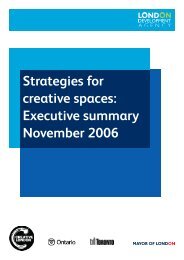Berlin Case Study - Cities Institute
Berlin Case Study - Cities Institute
Berlin Case Study - Cities Institute
Create successful ePaper yourself
Turn your PDF publications into a flip-book with our unique Google optimized e-Paper software.
• Professional school for technology and economics<br />
– area organisation<br />
• Workers’ welfare institution – volunteer social<br />
training year<br />
• District Friedrichshain Kreuzberg - NGA and civil<br />
engineering inspectorate<br />
• Artists and creatives from photography, screen art,<br />
design, internet technologies, literature and drama<br />
• Interested other quarters of the district and<br />
wider <strong>Berlin</strong><br />
• Media partners – press, radio, TV<br />
Bringing art into the neighbourhoods<br />
The contribution of culture to neighbourhood<br />
improvement was recognised early on <strong>Berlin</strong> Senate<br />
(2004): “Culture adds colour to every day life, and to<br />
the local community” (www.stadtentwicklung.berlin.<br />
de/wohnen/quartiersmanagement/index_en.shtml),<br />
Neighbourhood Fund projects have ensured<br />
that people do not have to go elsewhere to enjoy<br />
the bright lights. The emphasis was placed on<br />
encouraging creativity along with simply making<br />
visible the varied culture that many of the quarters<br />
already possessed.<br />
One area, Neukölln hosted Under Cover of Darkness,<br />
part of a cultural event ‘Shimmering Thursdays’.<br />
This fortnightly event helped to improve the<br />
image of the quarter among the local residents.<br />
Improving that image was one of the motives of<br />
a residents’ initiative to apply for money from the<br />
Neighbourhood Fund with which to present the<br />
cultural scene in the quarter on a regular basis. At<br />
the same time the cultural Thursdays extended the<br />
culture on offer to the local people and with its high<br />
profile also helped to promote the participating<br />
artists and thus indirectly to improve their economic<br />
situation. At the start of the series, which promised<br />
in its sub-title “Cultural mis-guidance around the<br />
Schillerpromenade”, the author Pieke Biermann read<br />
from one of her crime thrillers in the entrance hall<br />
of the Carl-Legien Secondary School. This Residents’<br />
initiative received funding of €45,372 to promote<br />
district culture and local business.<br />
This inspired a second project, the Cultural Office<br />
Schillerpromenade that aimed at raising the profile<br />
of the potential in the quarter and promoting the<br />
artists by networking. The neighbourhood jury<br />
allocated €40,000 to the applicants Förderband e.V.<br />
for two modules.<br />
Firstly, a Culture Office in the neighbourhood was<br />
set up. Funds were used for rent and equipment. The<br />
Culture Office has been organising exhibitions and<br />
is the place artists and creative people in the quarter<br />
come to first.<br />
As a second module, four project days were organised<br />
in April 2002 with 12 dance and performance<br />
artists from the neighbourhood. These project days<br />
promoted local networking and supported not<br />
only the dialogue between art forms, but also the<br />
exchange between professionals and amateurs.<br />
Street art<br />
The existing youth culture group Schlesische 27<br />
received funding of €44,175 to promote district<br />
culture, the integration of diverse social and ethnic<br />
groups, and the social infrastructure of schools,<br />
children, young people, senior citizens, and families.<br />
Schlesische 27 used the funds to plan and carry out<br />
cultural festivals for local street artists and residents.<br />
Each festival was stretched in organic shape of a river<br />
throughout the borough with the intention to<br />
signalise a flood of Street Art passing the streets<br />
of the area.<br />
Each festival involved local geographical features<br />
(e.g. special stages at every crossing named after<br />
the intersecting side streets) and integrated<br />
local children, young people and adults in the<br />
preparation works (e.g. creating river banks). Along<br />
the pavements, artists animated by-standers to fill<br />
the river bank with creative activities. Outdoors,<br />
music and drumming was on offer, along with<br />
theatrical performances and make-up tables for the<br />
children, but there were also theatre and drumming<br />
workshops in the project shop.<br />
38<br />
<strong>Berlin</strong> <strong>Case</strong> <strong>Study</strong>/appendix A




